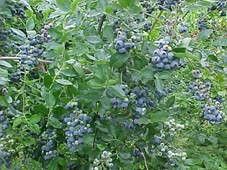 Rabbit Eye Blueberries!
Rabbit Eye Blueberries! Fall is an excellent time to enjoy gardening activities! With the arrival of cooler temperatures comes the ideal time to begin planting cool season annuals for winter and early spring colors in the landscape. One of the issues we sometimes have to cope with in the Fall is a lack of rainfall. Realize that it has been couple of weeks since we’ve received appreciable rainfall. Transplanting cool season annuals without adequate moisture is going to cause plants to get off to a slow start, that delays establishment. During dry periods, supplemental watering is highly recommended for root system establishment. Slow deep watering is a lot more effective than shallow watering. Additionally, adding a water soluble fertilizer will aid in critical root system establishment. It is also recommended that cool season bedding plants be mulched as soon as they are planted. Mulching helps to control weeds and also conserve moisture.
Along with temperature moderations comes the problem with Brown Patch Disease. The pathogen that causes brown patch disease is Rhizoctonia solani. Conditions that usually prompt brown patch disease are cool temperatures and moisture, yet the fact that we’ve had a dry weather pattern doesn’t seem to be hampering this disease in lawns. I’m receiving numerous calls, daily,regarding brown irregular patches in St Augustine, Centipede, and Zoysia lawns. It seems like St Augustine lawns are the most susceptible; although, all warm-season lawn grasses can be affected. We must also realize that if our weather pattern changes from dry to wet, we can expect the disease to become more aggressive. According to Dr. Ron Strahan, in order to suppress or slow down the spread of this disease in lawns, homeowners have the option of applying fungicides. Make two broadcast applications about 14 days apart. Several fungicides are labeled for lawn applications including Fertilome’s F – Stop ( active ingredient myclobutanil ), Scott’s Lawn Fungicide ( active ingredient thiophanate methyl ) and Heritage ( active ingredient azoxystrobin ). These fungicides are effective. While Heritage has been most effective, it is also the most expensive. Follow the label directions in terms of timing and rate of applications. Because brown patch disease can be active all winter and into the spring, a broadcast application of a fungicide next March may be helpful. However, if a rainy weather pattern develops and moisture is consistently present, brown patch will be much more aggressive.
I am also getting calls from homeowners regarding whether home lawns can benefit from an application of a fertilizer to winterize their lawns. There are those who believe that adding potash to lawns will help to increase winter hardiness which would allow the lawn to withstand cold injury and recover quicker in the spring. First, we must realize that our winters are not long and harsh enough to severely injure lawns. Secondly, many of the winterizing fertilizers are too high in nitrogen which could lead to decreased hardiness by promoting growth and also increasing the lawn grass’s susceptibility to brown patch disease. The LSU AgCenter recommends the application of potash to warm season lawns at this time of the year only if a soil test indicates low potassium. If so and a homeowner chooses to add potash, it should be in the form of 0-0-60 which is a fertilizer formulation only containing potash.
Now I will address bamboo and blueberries.
Utilizing bamboo for screening purposes in residential lawns can prove to become a problem because of the invasive nature of bamboo as it spreads and grows. Every year, I receive calls from homeowners who have questions about controlling bamboo in their yards that are encroaching from bamboo that neighbors have planted. Before planting bamboo, do your research before making a decision. Bamboo is available as running types and clumping types, with the running types being the most invasive. In fact, it is not recommended that the running types be planted unless bamboo barriers are installed at the time of planting.
The first fruit plant to be named as a Louisiana Super Plant is the Rabbit Eye Blueberry ( Vaccinium ashe ) which is a dual purpose shrub, native to Louisiana. Blueberries require an acid soil similar to azaleas, camellias, and gardenias. The best performing blueberries in Louisiana are the rabbit eyes which do well across the State. Some popular varieties are Climax,Tifblue, Brightwell, and Premier. Remember more than one variety should be planted to ensure adequate pollination.
Finally, if you notice that certain plants are showing signs of leaf spot or leaf drop, there is no reason to be concerned about applying fungicides. This occurs among pecans, oaks, figs, and magnolias trees. Among the broadleaf evergreens often affected are gardenias, citrus, azaleas, and hollies. This is common at this time of the year and there is no reason to be concerned.
Happy Gardening!!!Happy Gardening!!!Happy Gardening!!!

 RSS Feed
RSS Feed